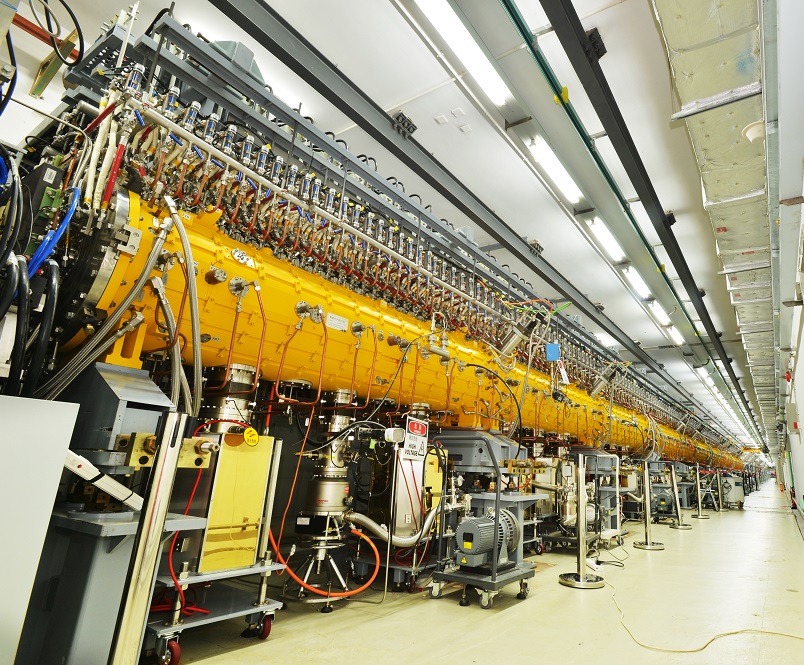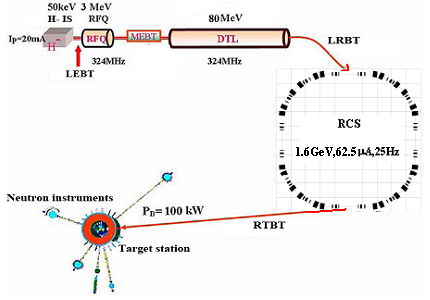1.1 Basic Design Parameters
The design principles for the CSNS are:
1) Leading role. On the one hand, it will be among the leading spallation neutron sources in the world; on the other hand, it can satisfy the increasing demand of the domestic scientists in different disciplines.
2) Operational availability. As a large platform open for broad users, the facility, especially the accelerator complex must be built to provide beam time almost on schedule. On the one hand, the failure time should be minimized and some installed spares are included in the design; and on the other hand, beam losses should be controlled in a very low level to allow hands-on maintenance for most accelerator components.
3) Cost rationality. The CSNS needs large investment in the construction and also large operation outlay. Therefore, it is a key issue to make the accelerator design rationally in cost.
4) Upgrading potential. Firstly, the CSNS accelerator will be designed in two phases to enable Chinese scientists to take the opportunity to use the advanced neutron scattering tool as early as possible. Secondly, the upgrading will be included in the design from the very beginning to make it realistic and efficient in cost. Thirdly, some reserve will be kept in the design when not confronting significant increase in cost.
| The Basic Parameters of CSNS |
| Name |
CSNS-I |
CSNS-II |
| Beam power(kW) |
100 |
500 |
| Repetition rate(Hz) |
25 |
25 |
| Target number |
1 |
1 |
| Average current(μA) |
62.5 |
312 |
| Proton energy(GeV) |
1.6 |
1.6 |
| Linac energy(Mev) |
80 |
250 |
The construction of a large-scale project such as China Spallation Neutron Source (CSNS) is a part of the national renovation on science and technology. Considering the actual development level of Science and Technology in China and the international development tendency, the proposal to construct a neutron source of 100 kW in beam power with the potential to be upgraded in the future has been approved by the Chinese Central Government. Following the conceptual and feasibility studies, CSNS will be built in two phases: 100 kW at CSNS-I and 500 kW at CSNS-II. The accelerator part has the reserved potential to be upgraded to 500 kW.

The Linac Tunnel
1.2 Accelerator Frame
High beam power proton accelerator is the key part in the construction of a spallation neutron source. Compared with other accelerator schemes for spallation neutron source, the CSNS accelerator scheme has the following aspects:
1) It is composed of a linac with a modest but upgradable energy and a rapid cycling synchrotron (RCS) of the fixed energy at 1.6 GeV. The space is reserved for adding more DTL tanks to increase the linac energy to 250 MeV at CSNS-II. This is a compromise between the construction cost for CSNS-I and the upgrading potential.
2) The repetition rate is chosen to be 25 Hz, even during the upgrading phases. This is chosen by the CSNS target-instruments.
3) The total beam loss rate in RCS is designed to be at a relatively low level. In order to achieve this, measures to counteract the space charge effects have been taken and a sophisticated collimation system has been designed, whereas the uncontrolled beam loss rate of 1W/m is maintained in the whole accelerator complex.

RCS before Installation

RCS after Installation
The CSNS-I accelerator train consists of: an H- ion source of PIG surface type that will produce a beam of 20 mA and low emittance, a low energy beam transfer line (LEBT) using magnetic focusing and electric beam chopping, a four-vane RFQ linac of 3 MeV, a medium energy beam transfer line (MEBT), four DTL tanks of 80 MeV at exit, a linac to RCS beam transfer line (LRBT) of 197 m in length including the reserved space for linac upgrading, an RCS of 1.6 GeV as the extraction energy, an RCS to target beam transfer line (RTBT) of 144 m in length. Whereas the linac and the RCS are cycling in 25 Hz, the two main beam transfer lines (LRBT and RTBT) work in the DC mode. The H- beam is converted to proton beam by a stripping foil at the RCS injection, and this is necessary to accumulate the required large number of protons in the RCS and to paint the linac beam of small emittance into the large acceptance in the RCS with good uniformity in both the transverse and the longitudinal phase planes.

Layout of CSNS Accelerators
In February 2020, the accelerator beam power reached its design goal of 100 kW. The speed of this progress at CSNS has outpaced that of similar facilities around the world such as those in the United States, Japan, and Europe. Throughout 2020, 4451 hours of effective target beam time were achieved, which greatly exceeded the planned time of 3800 hours. In addition, during the target beam time, the beam availability of the accelerator reached 93.6%. The measurement results in the tunnel after the weekly shutdown revealed that the induced radioactivity is far below the radiation dose limit required for manual maintenance, and the CSNS accelerator continues to demonstrate a safe, stable, and reliable operation even at high beam power.



